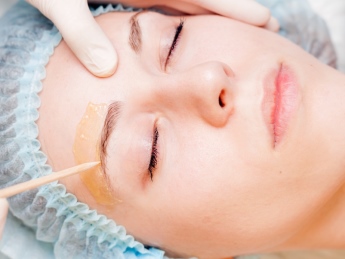
Women have removed excess hair on their face with wax for centuries and will probably continue to do so for centuries more. Caronlab Australia international training coordinator Holly Hayes explains how to perfect the basics.
What is the best type of wax for facial waxing?
It is important that you always use hard wax for all facial waxing as strip wax can be quiet harsh on the delicate skin. Using a high quality wax is extremely important. Look for waxes that are made with a synthetic resin rather than a pine resin as these are more reliable from batch to batch and also cause less irritation. Also look for a wax that contains Titanium Dioxide as this ingredient actively reduces redness and irritation. Whilst some people will always experience a slight redness after waxing we want to make sure the reactions and irritations are as minimal as possible.
What is the best method for applying wax to the face?
While the face is a small section of the body, there are still a few zones within the area that all need to be approached differently, for example; eyebrows. When waxing eyebrows it is imperative that we are able to create a neat curve with the wax so we can give our clients the perfect arch they are seeking. For this reason Brow Beater Spatulas are the perfect choice – they are thin and extremely flexible allowing you enough movement when applying the wax. For the upper lip I suggest using a cotton bud. Cotton buds are great because you can roll the tip of the bud upwards from the corner of the lip to the bottom of the nose. By being able to roll the wax on, the layer of wax stays even and in a clean line.
Does facial wax have to be heated/maintained at a lower temperature than wax for other areas of the body?
No. Wax should always be kept at the same temperature irrespective of the body part it is being use on. It is more important for a therapist to find and recognise the right consistency required for a perfect working wax, rather than a set temperature. Each heater is different so temperature and dial numbers are just a guide, not a rule of thumb.
What are the most common mistakes that therapists make when waxing a client’s face?
Some therapist use strip wax on the face but they shouldn’t as it can cause skin lifting, bruising and excessive redness if not an experienced waxer.
What are the best ways to avoid irritating the skin when waxing a client’s face?
The best way to avoid irritating a client’s face skin is simply to choose the right wax and perfect your waxing technique. There are other factors such as medications, lifestyle, beauty products etc. that can also play a role in how skin reacts to waxing, but most side effects are the direct result of a poor technique or an inferior wax.
Under what circumstances should a therapist not wax a client’s face?
If a client tells a therapist they have a skin condition or sensitive skin that may be aggravated by waxing the therapist should not wax without doing a text patch first. Therapists should also not wax clients who are being treated for acne with medication such as Roaccutane.
Caronlab has been supplying beauty salons in Australia and around the world with superior salon waxes and accessories since 1979. For more information visit www.caronlab.com.au

